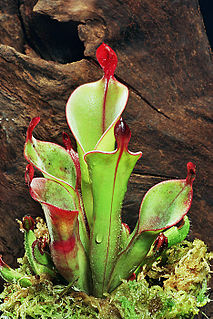
The genus Heliamphora contains 23 species of pitcher plants endemic to South America. The species are collectively known as sun pitchers, based on the mistaken notion that the heli of Heliamphora is from the Greek helios, meaning "sun". In fact, the name derives from helos, meaning marsh, so a more accurate translation of their scientific name would be marsh pitcher plants. Species in the genus Heliamphora are carnivorous plants that consist of a modified leaf form that is fused into a tubular shape. They have evolved mechanisms to attract, trap, and kill insects; and control the amount of water in the pitcher. At least one species produces its own proteolytic enzymes that allows it to digest its prey without the help of symbiotic bacteria.

Dr. Andreas Wistuba is a German taxonomist and botanist specialising in the carnivorous plant genera Heliamphora and Nepenthes. More than half of all known Heliamphora species have been described by Wistuba.
Dr. Joachim Nerz is a taxonomist and botanist specialising in the carnivorous plant genera Heliamphora and Nepenthes. Nerz has described several new species, mostly with Andreas Wistuba.

Heliamphora chimantensis is a species of marsh pitcher plant endemic to the Chimantá Massif in Venezuela. Specifically, it has been recorded from Apacará and Chimantá Tepuis. It is thought to be more closely related to the southern growing H. tatei and H. neblinae than to any of the other species found in the Gran Sabana and its tepuis. All other species known from this region have between 10 and 15 anthers, while H. tatei, H. neblinae and H. chimantensis have around 20. However, the anthers of H. tatei and the closely related H. neblinae are 7–9 mm long, while those of H. chimantensis only reach 5 mm in length.

Heliamphora folliculata is a species of Marsh Pitcher Plant endemic to the Aparaman group of tepuis in Venezuela. It grows on all four mountains: Aparaman Tepui, Murosipan Tepui, Tereke Tepui and Kamakeiwaran Tepui.
Heliamphora glabra is a species of marsh pitcher plant native to Serra do Sol in Venezuela. It was for a long time considered a form of H. heterodoxa, but has recently been raised to species rank.

Heliamphora heterodoxa is a species of marsh pitcher plant native to Gran Sabana in Venezuela. It was first discovered in 1944 on the slopes interlinking Ptari-tepui and Sororopan-tepui and formally described in 1951.
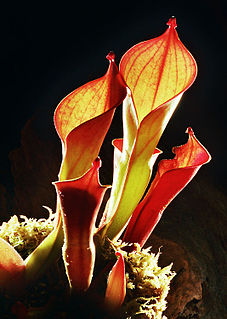
Heliamphora ionasi is a species of marsh pitcher plant thought to be endemic to the plateau that lies between the bases of Ilu Tepui and Tramen Tepui in Venezuela. It produces the largest pitchers in the genus, which can be up to 50 cm in height.

Heliamphora minor is a species of marsh pitcher plant endemic to Auyán-tepui in Venezuela. As the name suggests, it is one of the smallest species in the genus. It is closely related to H. ciliata and H. pulchella.

Heliamphora neblinae is a species of marsh pitcher plant endemic to Cerro de la Neblina, Cerro Aracamuni and Cerro Avispa in Venezuela. It is one of the most variable species in the genus and was once considered to be a variety of H. tatei. It is unclear whether or not there is a consensus regarding its status as a species, with at least a few researchers supporting the taxonomic revision that would elevate both H. tatei var. neblinae and H. tatei f. macdonaldae to full species status.

Heliamphora nutans is a species of marsh pitcher plant native to the border area between Venezuela, Brazil and Guyana, where it grows on several tepuis, including Roraima, Kukenán, Yuruaní, Maringma, and Wei Assipu. Heliamphora nutans was the first Heliamphora to be described and is the best known species.

Heliamphora pulchella is a species of marsh pitcher plant endemic to the Chimanta Massif and surrounding tepuis in Venezuela. It is one of the smallest species and closely related to H. minor.
Heliamphora sarracenioides is a species of marsh pitcher plant endemic to Ptari Tepui in Bolívar state, Venezuela. Approximately 200 mature plants were observed in the type locality, however this site's true location and information regarding sympatric species has not been disclosed for conservation reasons. The species differentiates itself from others by the extremely wide pitcher lid, which resembles Sarracenia species. It is closest to H. heterodoxa and H. folliculata, from which it can be distinguished by the large lid glands and width of the pitcher lid.

Heliamphora tatei is a species of marsh pitcher plant endemic to Cerro Duida, Cerro Huachamacari and Cerro Marahuaca in Venezuela. It is closely related to H. macdonaldae, H. neblinae, and H. parva, and all three have in the past been considered forms or varieties of H. tatei. Like H. tatei, these species are noted for their stem-forming growth habit.
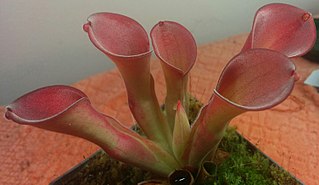
Heliamphora exappendiculata is a species of marsh pitcher plant native to the Chimantá and Aprada Massifs of Bolívar state, Venezuela. It was for a long time considered a variety of H. heterodoxa, but has recently been raised to species rank. Pitchers collect insects on flattened pitcher mouths which function as 'landing platforms' upon which prey falls from surrounding vegetation. Also, the pitcher shape effectively collects leaf litter and organic debris which may serve as additional source of nutrition for plants, similarly to H. ionasi.H. exappendiculata hybridizes naturally with H. pulchella and H. huberi in areas within which they grow together. This species occurs in shaded conditions, apparently preferring them over other habitats. In addition, plants upon Chimanta and Amuri Tepui grow directly upon the walls of gorges and ravines where surfaces are permanently wet. In contrast to those populations, on all other tepuis and massif regions the species grows on summit savannahs and stunted or shrubby forests, though these individuals represent a minority in habitat choice.
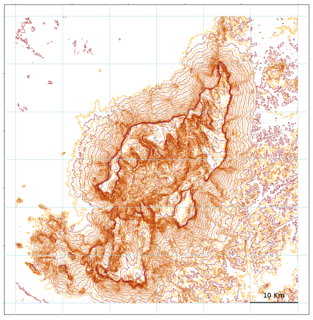
Cerro de la Neblina, also known as Serra da Neblina in Brazil and Sierra de la Neblina in Venezuela, is a sandstone massif located in the northern Amazon Basin. It is a tilted, heavily eroded plateau, with a deep canyon in its central portion, drained by the Baria River.
Heliamphora arenicola is a species of marsh pitcher plant known only from the western side of the Ilu–Tramen Massif in Venezuela's Gran Sabana, where it grows at elevations of less than 2000 m. It may also occur on Karaurin Tepui.

Heliamphora parva is a species of marsh pitcher plant known only from the Neblina Massif in Venezuela, where it grows at elevations of 1750–2200 m.
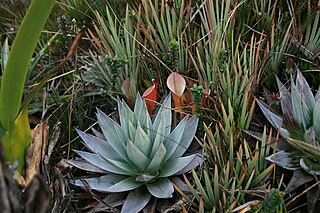
The natural range of the carnivorous plant genus Heliamphora is restricted to the southern Venezuelan states of Amazonas and Bolívar, and to adjacent portions of northern Brazil and western Guyana, an area corresponding to the western part of the Guayana Shield. These plants are largely confined to the summits and foothills of the sandstone table-top mountains of the region, known as tepuis.

Los Testigos, also known as the Aparamán range, is a mountain chain in Bolívar, Venezuela. It consists of four rather small tepuis, forming a bridge between the giant Auyán-tepui to the west and Ptari-tepui to the east. The four major peaks of Los Testigos are : Aparamán-tepui (2,100 m), Murisipán-tepui (2,350 m), Tereke-yurén-tepui (1,900 m), and Kamarkawarai-tepui (2,400 m), the latter three sharing a common slope area. There however remains some confusion in the literature regarding the names of these peaks.















